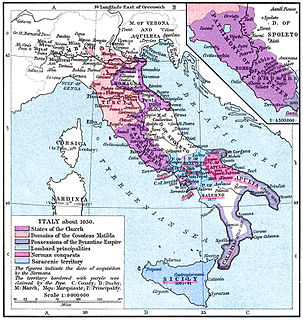
The Duchy of Carinthia was a duchy located in southern Austria and parts of northern Slovenia. It was separated from the Duchy of Bavaria in 976, and was the first newly created Imperial State after the original German stem duchies.

The House of Zähringen was a dynasty of Swabian nobility. Their name is derived from Zähringen castle near Freiburg im Breisgau.

Herman VI was Margrave of Baden and titular margrave of Verona from 1243 until his death.

Meinhard II, a member of the House of Gorizia (Meinhardiner), ruled the County of Gorizia and the County of Tyrol together with his younger brother Albert from 1258. In 1271 they divided their heritage and Meinhard became sole ruler of Tyrol. In 1286 he was enfeoffed with the Duchy of Carinthia and the adjacent March of Carniola.

The Imperial County of Ortenburg was a state of the Holy Roman Empire in present-day Lower Bavaria, Germany. It was located on the lands around Ortenburg Castle, about 10 km (6 mi) west of Passau. Though the Counts of Ortenburg—formerly Ortenberg—emerged in the 12th century as a cadet branch of the Rhenish House of Sponheim (Spanheim) who then ruled over the Duchy of Carinthia, an affiliation with the Carinthian Ortenburger comital family is unverifiable.
Adalbero of Eppenstein was Duke of Carinthia and Margrave of Verona from 1011 or 1012 until 1035.

Welf III, the last male member of the Swabian line of the Elder House of Welf, was Duke of Carinthia and Margrave of Verona from 1047 until his death.
Henry IV was Duke of Carinthia and Margrave of Verona from 1122 until his death. He was the first ruler of those territories from the Rhenish House of Sponheim.

The March of Verona and Aquileia was a vast march of the Holy Roman Empire in northeastern Italy during the Middle Ages, centered on the cities of Verona and Aquileia. Seized by King Otto I of Germany in 952, it was held by the Dukes of Bavaria; from 976 in personal union with the Duchy of Carinthia. The margravial regime ended with the advent of the Lombard League in 1167.

Otto I, a member of the House of Andechs, was Duke of Merania from 1204 until his death. He was also Count of Burgundy from 1208 to 1231, by his marriage to Countess Beatrice II, and Margrave of Istria and Carniola from 1228 until his death.
Engelbert II, a member of the House of Sponheim, was Margrave of Istria and Carniola from about 1103/07 until 1124. In 1123, he succeeded his elder brother Henry as Duke of Carinthia and Margrave of Verona which he held until his retirement in 1135.
Sponheim or Spanheim was a medieval German noble family, which originated in Rhenish Franconia. They were immediate Counts of Sponheim until 1437 and Dukes of Carinthia from 1122 until 1269. A cadet branch ruled in the Imperial County of Ortenburg-Neuortenburg until 1806.

The Counts of Ortenburg were a comital family in the mediaeval Duchy of Carinthia. Though they had roots in Bavarian nobility, an affiliation with the Imperial Counts of Ortenburg, a branch line of the Rhenish Franconian House of Sponheim, is not established.
Herman II of Spanheim, a scion of the Rhenish House of Sponheim, was Duke of Carinthia from 1161 until his death.
Siegfried I is considered the progenitor of the Carinthian ducal House of Sponheim (Spanheimer) and all of its lateral branches, including the Counts of Lebenau and the Counts of Ortenburg. He is documented as Count of Sponheim from 1044 and served as margrave of the Hungarian March in 1045/46 and as count in the Puster Valley and the Lavant Valley from 1048 until his death.

Ulrich III was the Lord in the March of Carniola from c. 1249 and Duke of Carinthia from 1256 until his death, the last ruler from the House of Sponheim. His rule had long-lasting consequences. In Carniola, he acquired the former Meranian possessions, thus becoming the first undisputed princeps terrae, provincial lord or landgrave, creating the power and legal basis of the future Duchy of Carniola. The center of his original Carniolan possessions, Ljubljana, became the new administrative center and thus the provincial capital, as well as the center of Ulrich's power. In Carinthia, which he took over after his father's death, his seal became the coat of arms of Carinthia up to today. Despite his attempts to secure the vast Babenberg inheritance through two marriages, first to Agnes of Merania, widow of the last Babenberg duke Frederick II of Austria, and then to Frederick's niece Agnes of Baden, Ulrich remained childless. After a short interregnum by his younger brother Philip of Spanheim, patriarch of Aquileia, the House of Spanheim went extinct, and all of Ulrich's possessions were inherited by his cousin Ottokar I of Bohemia.

Rudolph II, Count Palatine of Tübingen was Count Palatine of Tübingen and Vogt of Sindelfingen. He was the younger son of Rudolph I and his wife Matilda of Gleiberg, heiress of Giessen.

Henry V, of the House of Spanheim, was the margrave of Verona from 1144 until 1151 and the duke of Carinthia from 1144 to his death. According to the contemporary chronicler Otto of Freising, Henry was "a valiant man, experienced in the councils of war".
Rudolf I, Margrave of the Nordmark and Count of Stade, son of Lothair Udo II, Margrave of the Nordmark, and Oda of Werl, daughter of Herman III, Count of Werl, and Richenza of Swabia. Rudolf was the brother of his predecessors Henry I the Long and Lothair Udo III.

Frederick I of Celje also Frederick I of Cilli, was a Styrian free noble who became the first Count of Celje, founding a noble house that would dominate Slovenian and Croatian history in the first half of the 15th century.












